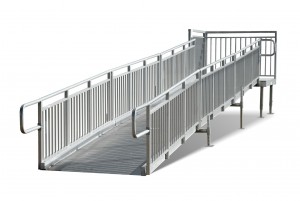REDD Team access ramps for the disabled are found in public and private facilities across the country. People turn to us because they know we have a reputation for outstanding quality, and a commitment to delivering the highest levels of customer service. When you work with REDD Team, you’ll be working with a team of passionate professionals who will do everything we can to ensure your complete satisfaction.
The ADA and You
 The Americans with Disabilities Act (ADA) is a law Congress passed in 1990 to ensure everyone with physical challenges would have the same level of access to public buildings as those without challenges. Failure to comply with the ADA can carry severe consequences, including fines and possibly even legal action.
The Americans with Disabilities Act (ADA) is a law Congress passed in 1990 to ensure everyone with physical challenges would have the same level of access to public buildings as those without challenges. Failure to comply with the ADA can carry severe consequences, including fines and possibly even legal action.
REDD Team can ensure you never have to deal with those headaches. Our ramps and other accessibility system products comply with not only the ADA, but also all other local, state and federal mandates. We have more than a quarter-century of experience manufacturing durable, reliable aluminum components, including ramps, stairs, platforms, walkways and more.
You’ll find our products in a wide variety of applications. We can provide you a temporary or permanent solution that will meet all of your accessibility needs. Commercial, industrial, military and other organizations have worked with us, and we look forward to the opportunity to work with you as well.
ADA Ramp Regulations
If you take a look at ADA requirements, it would be understandable if you were a bit confused. ADA guidelines are extensive, and it would take a long, long time for most people to comprehend them. But REDD Team professionals are experts in everything that has to do with the ADA, so you don’t have to be.
Here’s just a brief look at just a few of the ADA requirements as they pertain to ramps. However, it’s important to note that there can often be differences between ADA standards and those set by individual cities and counties. Check with your local building authorities to make sure you’re in compliance with all accessibility regulations.
- The ADA terms any so-called “path of travel,” one that has a rise of one unit for every 20 units of horizontal distance as a ramp. The slope of a ramp run can’t have more than a 1:12 ratio of steepness. The cross slope can’t be in excess of a 1:48 ratio. The rise of the ramp can’t exceed 30 inches, and the width must be at least 36 inches. There are exceptions in some cases. Get in touch with us and we’ll tell you more.
- The landings at the top and bottom of the ramp must be level. They must be at least 60 inches long, and must be as wide as the widest portion of the ramp run. If the direction of the ramp changes, there must be at least a 60-inch wide landing at the point of intersection.
- Handrails must also be available on both sides if the rise of the ramp is more than 6 inches. The ramps have to extend no less than 12 inches from the end portion of the ramp, and must be from 34-38 inches high.
These just scratch the surface of ADA requirements as they pertain to access ramps for the disabled. At REDD Team, we know the ADA inside and out. We’re experts, and we’re ready to put that expertise to work for you. Give us a call at 800-648-3696 or use our online contact form to learn more.
